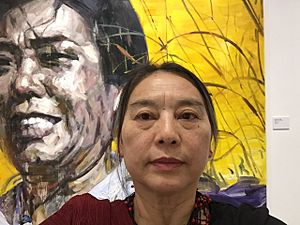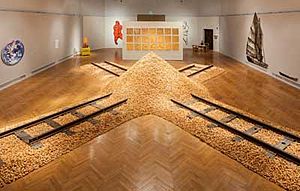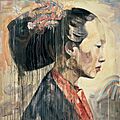Hung Liu facts for kids
Quick facts for kids
Hung Liu
|
|
|---|---|

In front of her painting from her "Daughters of China" series
|
|
| Born | 17 February 1948 |
| Died | 7 August 2021 (aged 73) Oakland, California, United States
|
| Education | Beijing Teachers College, Central Academy of Fine Arts, University of California, San Diego |
| Known for | Painting, mural painting |
| Awards | Joan Mitchell Fellowship (1998), SECA award (1992), Eureka Fellowship (1993), SGC International Award for Lifetime Achievement (2011) |
Hung Liu (劉虹) (born February 17, 1948 – died August 7, 2021) was an important Chinese-born American artist. She was mostly known for her paintings, but she also created art using different materials and made special art for specific places. She was one of the first artists from China to become famous in the United States.
In 1998 and 1999, a special show of Liu's art from the past ten years traveled across the U.S. This show, called Summoning Ghosts: The Art of Hung Liu, featured paintings from over 40 different art collections.
| Top - 0-9 A B C D E F G H I J K L M N O P Q R S T U V W X Y Z |
Early Life and Art in China
Hung Liu was born in Changchun, China, in 1948. Soon after she was born, her father was put in prison because he was part of a political group. In 1958, when she was 10, Hung Liu moved to Beijing.
In 1970, during China's Cultural Revolution, Liu was sent to a small village called Huairou. She lived and worked there with the local people from 1968 to 1972. Later, she studied at Beijing Teachers College and then learned about mural painting at the Central Academy of Fine Arts in Beijing.
During her art training, Liu faced strict rules. Artists had to follow a very specific style, almost like painting by numbers. But Liu secretly rebelled. Even though cameras were not allowed for art, she took photos of local farmers and their families in Huairou. She then used these photos to make her own drawings.
Hung Liu's Art Style
Hung Liu's paintings and prints often had many layers of brushstrokes. She also used thin washes of linseed oil, which made her images look like they were dripping. Her art was often inspired by old and new photos of Chinese people, especially women, children, refugees, and soldiers.
Some people say her dripping style was a way to show how historical memories can fade or become blurry. Her art partner, Jeff Kelley, called her painting style a kind of "weeping realism" because it often showed deep feelings.
Liu believed her paintings gave "a spirit to them, the forgotten." Her art helped bring details of Chinese history and memory to people in America. She challenged the idea that historical photos always show the full truth. By painting over them, she showed how memories change over time.
Since the late 1990s, Liu also used historical photos of non-Chinese women, refugees, workers, and children as inspiration. She used images from photographer John Thomson in some of her Chinese-themed paintings. In her American Exodus series, she focused on American subjects, like the Dust Bowl and the Great Depression, inspired by photos from Dorothea Lange.
Some of Liu's artworks included other objects, like old or handmade items. She would place these objects near her paintings or even attach them directly to the art. Liu saw her installation art as a way to continue her mural painting skills, working on a large scale and considering the specific place where the art would be shown.
My Secret Freedom Paintings
Hung Liu also created a series of paintings called "My Secret Freedom." She made these tiny landscape paintings during a time when the Maoist government did not allow unauthorized art. These paintings showed scenes of everyday life. The title "My Secret Freedom" refers to how rebellious it was to create them. Liu had to hide a small paint box and brushes under her coat and paint each tiny image very quickly. This was her way of painting just for the joy of it, not for the government.
Moving to America and Resident Alien
Liu moved to the United States in 1984. She studied at the University of California, San Diego, and finished in 1986.
In 1988, as an artist-in-residence in San Francisco, Liu created a series of works about identity as an immigrant. One famous piece was her self-portrait, Resident Alien. In this painting, she made a huge version of her own green card. She changed her birthdate to 1984 (the year she moved) and replaced her name with "Fortune Cookie." This painting became very well-known and was discussed by many scholars. It showed the challenges of being an immigrant and how Liu resisted being put into stereotypes. In 1988, Liu also painted a mural called Reading Room in San Francisco's Chinatown.
"Jiu Jin Shan (Old Gold Mountain)"
Liu's art installation Jiu Jin Shan (Old Gold Mountain) (1994) was first made for the de Young Museum. For this artwork, Liu built a "gold mountain" using 200,000 fortune cookies. It surrounded a place where railroad tracks crossed. The tracks represented the meeting of Eastern and Western cultures. They also honored the Chinese immigrants who died while building the transcontinental railroad through the Sierra Nevada mountains. This artwork was also shown at the Mills College Art Museum in 2013.
"Going Away, Coming Home" Airport Art
In November 2006, Liu's public art piece called Going Away, Coming Home was shown at the Oakland International Airport. It's a 160-foot long wall of windows in Terminal 2. The airport asked her to create this art.
The artwork shows 80 cranes. These cranes are meant to bring comfort and good wishes to people who are leaving home or returning from a trip. Liu was inspired by a 12th-century Chinese silk painting that also showed cranes as symbols of good luck. Liu painted the cranes with enamel, using her signature dripping style. She worked with a German glass company to create this large piece.
Summoning Ghosts Art Show
Summoning Ghosts: The Art of Hung Liu was a large collection of Liu's work. It included about 80 paintings, plus photos, studies, and sketchbooks. It is the biggest show of her art so far, with paintings from over 40 different collections. The exhibit showed art from Liu's whole career, starting in the late 1960s. These paintings were inspired by her own life and experiences during the Maoist regime, the Great Leap Forward, and the Cultural Revolution in China. The show also included themes from ancient China. Hung Liu worked with Réne de Guzman, the chief curator at the Oakland Museum of California, to organize the exhibit. Liu described the show as a "full circle" of her journey as an artist.
Awards and Achievements
Hung Liu received many awards for her art. These include two painting fellowships from the National Endowment for the Arts and a Joan Mitchell Fellowship. In 2011, she won an award for her lifetime achievements in printmaking. She also received a SECA award and a Eureka Fellowship.
She was a Professor Emerita of Painting at Mills College in Oakland, California. She taught there from 1990 until she retired in 2014.
Death
Hung Liu passed away from pancreatic cancer on August 7, 2021, in Oakland, California. At the time of her death, the de Young Museum in San Francisco had a collection of her work on display. Another exhibition, "Hung Liu: Portraits of Promised Lands," opened at the Smithsonian's National Portrait Gallery in August 2021.
Collections
Hung Liu's art can be found in many public collections, including:
- National Museum of Women in the Arts, Washington, DC
- San Francisco Museum of Modern Art, San Francisco, California
- Whitney Museum of American Art, New York City, New York
- Metropolitan Museum of Art, New York City, New York
- National Gallery of Art, Washington, D.C.
- Asian Art Museum, San Francisco, California
- Los Angeles County Museum of Art, Los Angeles, California
- San Jose Museum of Art, San Jose, California
- University of Oregon Museum of Art, Eugene, Oregon
- Muscarelle Museum of Art, Williamsburg, Virginia
Exhibitions

Hung Liu's art has been shown in many exhibitions and places, such as:
- Portraiture Exhibition, Beijing, China; 1978
- National Fine Arts Colleges Exhibition, a traveling show in China; 1980
- Resident Alien, San Jose Museum of Art, CA; 1988
- Goddesses of Love and Liberty, New York, NY; 1989
- 43rd Biennial of Contemporary American Painting, Corcoran Gallery of Art, Washington, DC; 1993
- The Last Dynasty, New York, NY; 1995
- American Kaleidoscope, Smithsonian American Art Museum, Washington, DC; 1996
- Hung Liu: A Ten-Year Survey, 1988-1998, traveled to several museums including Muscarelle Museum of Art, Williamsburg, Virginia; Kemper Museum of Contemporary Art, Kansas City, Missouri; and Ackland Art Museum, Chapel Hill, North Carolina (1998-1999).
- Strange Fruit: New Paintings by Hung Liu, traveled to several museums including Arizona State University Art Museum, Tempe, Arizona; Boise Art Museum, Boise, Idaho; and Crocker Art Museum, Sacramento, California (2002-2003).
- Hung Liu: Toward Peng-Lai (Paradise), San Francisco, CA; 2003
- Daughters of China, San Francisco, CA; 2007
- Summoning Ghosts, Oakland Museum of California (2013); then traveled to Kemper Museum of Contemporary Art, and Palm Springs Art Museum.
- Hung Liu: Daughter of China, Resident Alien; American University Museum at the Katzen Art Center, Washington, D.C.; 2016
- Hung Liu: Portraits of Promised Lands, National Portrait Gallery, Washington, D.C., 2021
Images for kids
-
The Hung Liu: The Long Way Home exhibition at The Grace Museum in Abilene, Texas









